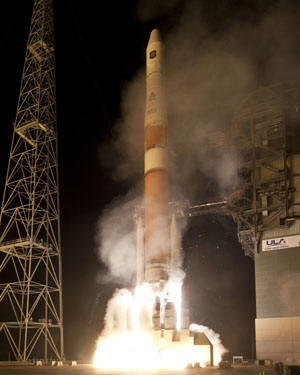|
|||||||||||
|
|
|
|||
|
By Jim Douglas |
||||
 |
May 29, 2010 -
Boeing has acquired the first on-orbit signals from the Global
Positioning System (GPS) IIF-1 satellite, the inaugural spacecraft in a
12-satellite constellation that the company is building for the U.S. Air
Force. The signals indicate that the spacecraft bus is functioning
normally and ready to begin orbital maneuvers and operational testing.
A United Launch
Alliance Delta IV rocket launched the GPS IIF-1 satellite at 11 p.m.
Eastern time on May 27 from Cape Canaveral Air Force Station. At 2:33
a.m., the satellite separated from the rocket's upper stage, and a
ground station on Diego Garcia in the
The Air Force 19th
Space Operations Squadron and Boeing's GPS is the U.S. Department of Defense's largest satellite constellation, with 30 spacecraft on orbit. The GPS IIF satellites will provide more precise and powerful signals, a longer design life, and many other benefits to nearly 1 billion civilian and military users worldwide. |
|||
|
|
||||
|
"The inaugural
launch of the GPS IIF-1 is a milestone in Boeing's 30 years of support
to the Air Force that goes back to the first days of this program," said
Craig Cooning, vice president and general manager, Boeing Space and
Intelligence Systems. "The new GPS IIF satellites bring key
improvements, including a more jam-resistant military signal, a new
civil signal to enhance commercial aviation and search-and-rescue
operations, and significantly improved signal accuracy as more of these
new satellites go into operation."
The GPS IIF-1
satellite will undergo months of on-orbit tests, including functional
testing of its payloads and end-to-end system testing to verify
operability with older GPS satellites, ground receivers, and the ground
control system. Boeing has production of the next 11 GPS IIF satellites well under way as it implements an innovative pulse-line manufacturing approach that will help deliver the satellite fleet on schedule. Adapted from Boeing aircraft and helicopter assembly lines, the Boeing GPS IIF pulse line efficiently moves satellites under development from one work area to the next in a steady, pulse-like rhythm. The second GPS IIF satellite is scheduled for launch later this year. |
||||


